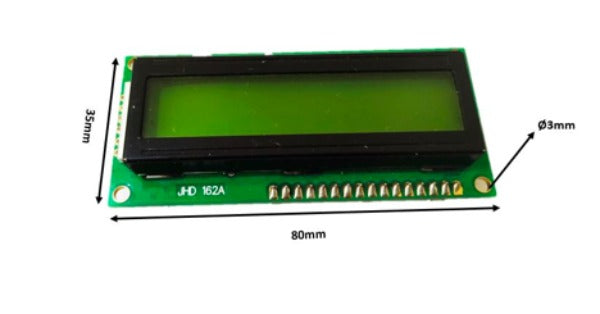The 16x2 is the most commonly used LCD display module. It can display 16 characters in a column for 2 rows thus a total of 32 characters. The characters can either be number, alphabets or symbol. It is also possible to create your own custom character and display it if required. The LCD has the HD44780U display driver IC which is responsible for displaying characters on the LCD
This 16x2 LCD display has a blue background and back light which makes it unique and more visible than the commonly used green color. If you need the green backlight you can use this Green Backlight LCD. The required supply voltage is from 4.7V to 5.3V and the LCD can operate either in 8-bit mode or in 4-bit mode allowing you to save more GPIO pins on the controller side. The current consumption is about 1mA without the back light.
16x2 LCD Display Module Specifications:
-
Operating Voltage: 4.7V to 5.3V
-
Operating Current 1mA (without backlight)
-
Can display (16x2) 32 Alphanumeric Characters
-
Custom Characters Support
-
Works in both 8-bit and 4-bit Mode
The 16x2 LCD pinout diagram is shown below. As you can see the module has (from right) two power pins Vss and Vcc to power the LCD. Typically Vss should be connected to ground and Vcc to 5V, but the LCD can also operate from voltage between 4.7V to 5.3V. Next, we have the control pins namely Contrast (VEE), Register Select (RS), Read/Write (R/W) and Enable (E). The Contrast pin is used to set the contrast (visibility) of the characters, normally it is connected to a 10k potentiometer so that the contrast can be adjusted. The Read/Write pin will be grounded in most cases because we will only be writing characters to the LCD and not read anything from it. The Register Select (RS) and Enable pin (E) pin are the control pins of the LCD and will be connected to the digital pins GPIO pins of the microcontroller. These pins are used to instruct the LCD where place a character when to clear it etc.

From DB0 to DB7 we have our eight Data Pins which are used to send information about the characters that have to be displayed on the LCD. The LCD can operate in two different modes, in the 4-bit Mode only pins DB4 to DB7 will be used and the pins DB0 to DB3 will be left idle. In 8-bit Mode, all the eight-pin DB0 to DB7 will be used. Most commonly the 4-bit mode is preferred since it uses only 4 Data pins and thus reduces complexity and GPIO pin requirement on the microcontroller. Finally, we have the LED+ and LED- pins which are used to power the backlight LED inside our Display module. Normally the LED+ pin is connected to 5V power through a 100 ohm current limiting resistor and the LED- pin is connected to Ground.
16x2 LCD Display Pinout Configuration:
|
Pin No.
|
Pin Symbol
|
Pin Name
|
Connection Description
|
|
1
|
VSS
|
Ground
|
Connected to Ground
|
|
2
|
VCC
|
Power
|
Connected to Power (Typically 5V)
|
|
3
|
VEE
|
Contrast
|
Connected to potentiometer 10k to control contrast
|
|
4
|
RS
|
Register Select
|
Connected to Microcontroller
|
|
5
|
R/W
|
Read/Write
|
Connected to Ground
|
|
6
|
E
|
Enable
|
Connected to Microcontroller
|
|
7
|
DB0
|
Data Pin 0
|
Connected to Microcontroller based on 4-bit or 8-bit Working Mode
|
|
8
|
DB1
|
Data Pin 1
|
|
9
|
DB2
|
Data Pin 2
|
|
10
|
DB3
|
Data Pin 3
|
|
11
|
DB4
|
Data Pin 4
|
|
12
|
DB5
|
Data Pin 5
|
|
13
|
DB6
|
Data Pin 6
|
|
14
|
DB7
|
Data Pin 7
|
|
15
|
LED+
|
LED Positive
|
Connected to 5V through 100 ohm Resistor
|
|
16
|
LED-
|
LED Negative
|
Connected to Ground
|
The dimensions of 16x2 LCD display is shown below

Further Resources:

